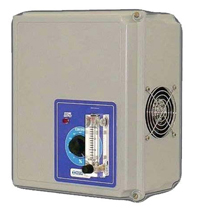Ozone is a pungent gas naturally produced in the earth's upper atmosphere by the action of uv sunlight on oxygen molecules. Ozone can be created for water treatment purposes by sending air through a special chamber containing a high-voltage "spark," which creates a blue plasma corona; it is also produced by sending air through a chamber of ultraviolet light.
ozone is a powerful oxidizer similar to chlorine. Many of the same benefits we get from chlorinating water (disinfection, oxidation of metals, etc. ) is also realized by using ozone gas, except that with ozone, there is no chemical residual left in the water. Chlorine can combine with organic material in water to produce toxic compounds, such as "thms".
Because of its active characteristic, ozone cannot be stored. So it is generated on-site near its point of use. Ozone is generated by the exposure of air or pure oxygen to a high-energy source such as a high voltage electrical discharge (corona discharge), photochemical reaction (uv light), high or low electrical frequencies or high-energy radiation. The most widely used procedure is the corona discharge method because it produces the highest concentration of ozone for the amount of electrical energy applied and currently is considered to be the only practical method of generating ozone in large scale quantities.

In the corona discharge method a dry, oxygen-containing gas (air or pure oxygen) is passed between two electrically charged plates separated by a ceramic dielectric and a narrow discharge gap while a high voltage alternating current is applied. Under these conditions a portion of the oxygen in the feed gas is converted to ozone in the following manner:
o2+e 2[o]+heat
2[o]+202= 203
Because ozone is only slightly soluble in water, at the partial pressure at which it is generated and applied, contacting ozone with water involves bringing bubbles of ozone-containing air or oxygen into intimate contact with the water.
The ozonation process may be divided into four main parts: gas preparation, electrical power supply, ozone generation and contacting. Associated with these basic components are additional subunits such as controls, instrumentation, cooling water and/or cooling air supply, ozonized gas and water are generally brought into close proximity in a contractor, usually a venture injector type. Mass transfer of ozone from the gaseous bubbles occurs across the gas/liquid interface into the water.

